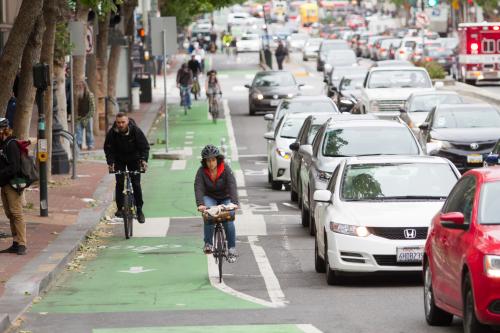The New York Times sent a chill through its readers last week with their incredible story, “Your Apps Know Where You Were Last Night and They’re Not Keeping It Secret.” It reported how, thanks to the location technologies on which our mobile phones run, companies are collecting unprecedented amounts of data on where and how we spend our time, and they are profiting off it. The headline animation from the story underscores the massive extent of this passive surveillance, illuminating 235 million locations drawn from 1.2 million devices people carried around New York over three days in 2017.
The story’s closing quote—“You have to turn this off. You have to delete this”—suggests the threats to privacy that these location data present. Yet the article fails to acknowledge the benefits these data can—and do—provide to consumers and citizens. Smart efforts to regulate the use of location services data should weigh these benefits alongside the clear imperatives to protect anonymity and sensitive individual information. (And no, we don’t get paid to tout data collection from the big five.)
The modern economy operates under the premise of always-on connectivity, whether that’s making a phone call or accessing data in real time. To provide that connectivity, telecom providers need to know where we are at all times—and to do that, they rely on a network of cell towers to constantly track our locations. Do you want family and friends to be able to reach you wherever you are? Do you want to consume news and social media on your train ride home? If so, the providers need those pings.
The modern economy operates under the premise of always-on connectivity, whether that’s making a phone call or accessing data in real time. To provide that connectivity, telecom providers need to know where we are at all times.
Once they have that data, companies can provide better services and experiences to us. Whether it’s mapping the most efficient routes that avoid backed-up roads or warning us when the coffee shop we’re about to visit is “busier than usual,” location services data are changing how we interact with the environment around us. Transportation companies like Lyft can adjust pricing to demand, while Google Maps updates travel times on the fly. Location services are the digital backbone that enable many applications that have transformed our lives for the better.
Those are examples of largely private benefits to individuals and companies. But the public sector stands to benefit greatly from improved location data, which they’re just beginning to learn how to manage.
When planners design new zoning rules for a city neighborhood, or transportation officials decide on investments like a new train line, they typically rely on outmoded data like traveler diaries, rider surveys, or just maps of existing populations and systems. (Is it any wonder, then, that public transportation use has fallen while private, tech-enabled mobility services expand?)
The future will look different, though. Location services data can highlight common travel patterns that take too long because private vehicles overwhelm transit capacity. The same data can help us identify the most dangerous streets for pedestrians, bikers, and drivers alike, so we can make safety improvements. It can test Jane Jacob’s conditions for urban diversity, to determine what makes livable, vibrant cities. We can better understand what types of zoning and local businesses contribute to active areas where people want to visit, and spend their time and money.
A recent study detailed by Richard Florida in CityLab shows how geospatial data can help us to better understand social and economic segregation within cities. Using Twitter data (not even the best location data) the study authors found that minority households not only live in segregated neighborhoods, but also tend to travel to racially segregated neighborhoods, potentially reinforcing their social and economic isolation.
Yet even if location data will continue to improve our world, the Times article is absolutely right to highlight the need to regulate these sensitive data. There is clearly a breakdown in expectation between what users believe they offer and what companies collect, even if disclosure statements legally protect all the data collection. The Times investigation shows how easy it is to violate that trust.
There is clearly a breakdown in expectation between what users believe they offer and what companies collect, even if disclosure statements legally protect all the data collection.
This is a perfect place for a new Congress and its partners at the Federal Trade Commission and Federal Communications Commission to get to work. How can we protect the benefits, real and prospective, that these data can provide? Who should have access to sensitive individual data, and who should only see anonymized, aggregated versions? What is the appropriate agency to regulate these activities?
The country needs to have these debates, which the Times article helpfully provokes. As we do so, we should keep in mind not only the peril, but also the promise, of location data for advancing a more efficient and equitable society.








Commentary
The New York Times exposed the risk of tracking our location, but let’s not forget the benefits
December 18, 2018